This post may contain affiliate links. Please see our disclosure policy.
Canning peaches is the prefect beginner water bath canning project, and there’s no better way to preserve peaches at home. Enjoy the taste of summer peaches throughout the year in pies, baked goods, and more!

Where I live, the arrival of in-season peaches is a clear sign that summer is at its peak. The days are long and languid, spent outdoors in the sunshine, and fruit is at a surplus (with sweet, beautiful peaches being my absolute favorite). If you’ve ever had the misfortune of eating peaches when they’re out of season then you’ll know how disappointing they are. Grainy and flavorless, these sad peaches are a mere shadow of summer peaches.
This is where canned peaches come in. Not the overly sweet variety found in the grocery store sitting in heavy syrup, but the homemade canned peaches that taste and smell just as amazing on a cold day in the middle of December as they would have freshly picked from the tree when temperatures were significantly warmer. You may be surprised to learn that canning peaches at home is surprisingly simple and requires very few ingredients, just the best peaches you can get your hands on!
This comprehensive guide to canning peaches breaks down the entire process, step-by-step. From the best peaches to use (and which ones to avoid), how to choose the best canning liquid according to your taste, to everything you need to know about successful water bath canning or pressure canning. I’ve also included a section on troubleshooting common home canning issues in addition to quick FAQs about canning peaches.
Looking for inspired ways to use your canned peaches? You’ll find my favorite ideas and uses for both the fruit and the syrup below, including tips for maximizing the shelf life and appearance of canned peaches.

Ingredients for Canning Peaches
This recipe is minimalist for a reason—these canned peaches preserved in a light syrup taste like they were freshly picked on a hot summer day. To make these canned peaches the only ingredients you’ll need are:
- Peaches
- Granulated sugar (+water to make syrup)
- Lemon juice (optional, to prevent discoloration of sliced fruit before canning)
Honey and maple syrup can be used as a substitute for sugar (see below for instructions). You can also use juice as a canning liquid, just omit the sugar and water—I suggest apple or white grape juice. For added flavor, vanilla beans, and cinnamon sticks can be added to the jars with the peaches.
Best Canning Peaches
When it comes to choosing the best type of peach for canning, the sky is basically the limit (*with one exception). Because yellow-fleshed peaches are a high-acid food, all varieties are considered safe for water bath canning and pressure canning.
There are a few other factors to think about when choosing yellow-fleshed peaches for canning:
- Size of the fruit: If you have the option, choose larger peaches over smaller peaches as this will save you time in terms of peeling the fruit. However, if you’re using smaller jars or if you plan on canning your peaches halved or whole, you might want to choose peaches on the small to medium side.
- Freestone vs. clingstone: Freestone peaches are the go-to option for canning nowadays. You can find them in any grocery store or farmers market and the fact that the loosen from the pit so easily makes prepping them a snap. I will say, however, that clingstone peaches are absolutely worth the extra effort in terms of flavor. Fair warning, after separating the peach flesh from the pit you may have to sacrifice the appearance of neatly sliced peaches for more rustic chunks of fruit.
- Ripeness: Although you might be tempted to reach for super-ripe peaches for best flavor, choose peaches that are barely ripe for canning. Look for peaches that are still very firm, but have lost all touches of green around the stem. If the peaches are too ripe they have a tendency to fall apart during the canning process (especially if you plan on pressure canning).
*The one exception? White-fleshed peaches. Peaches with white flesh are a low-acid food, which in this context means they may not meet the pH requirements for safe canning (in order for food to be considered safe for canning, it needs to have a pH level that’s below 4.6). In theory, lemon juice or citric acid could be added to the canning liquid to shift the pH in the right direction but for safety’s sake, but I strongly recommend sticking with yellow-fleshed peaches for canning.
If you find yourself with a surplus of white peaches you can always freeze the fruit by halving, quartering, and/or slicing the peaches and then freezing in a single layer. Once the peaches are frozen solid, pack them into resealable freezer bags or containers to use whenever you’re in the mood for white peaches.
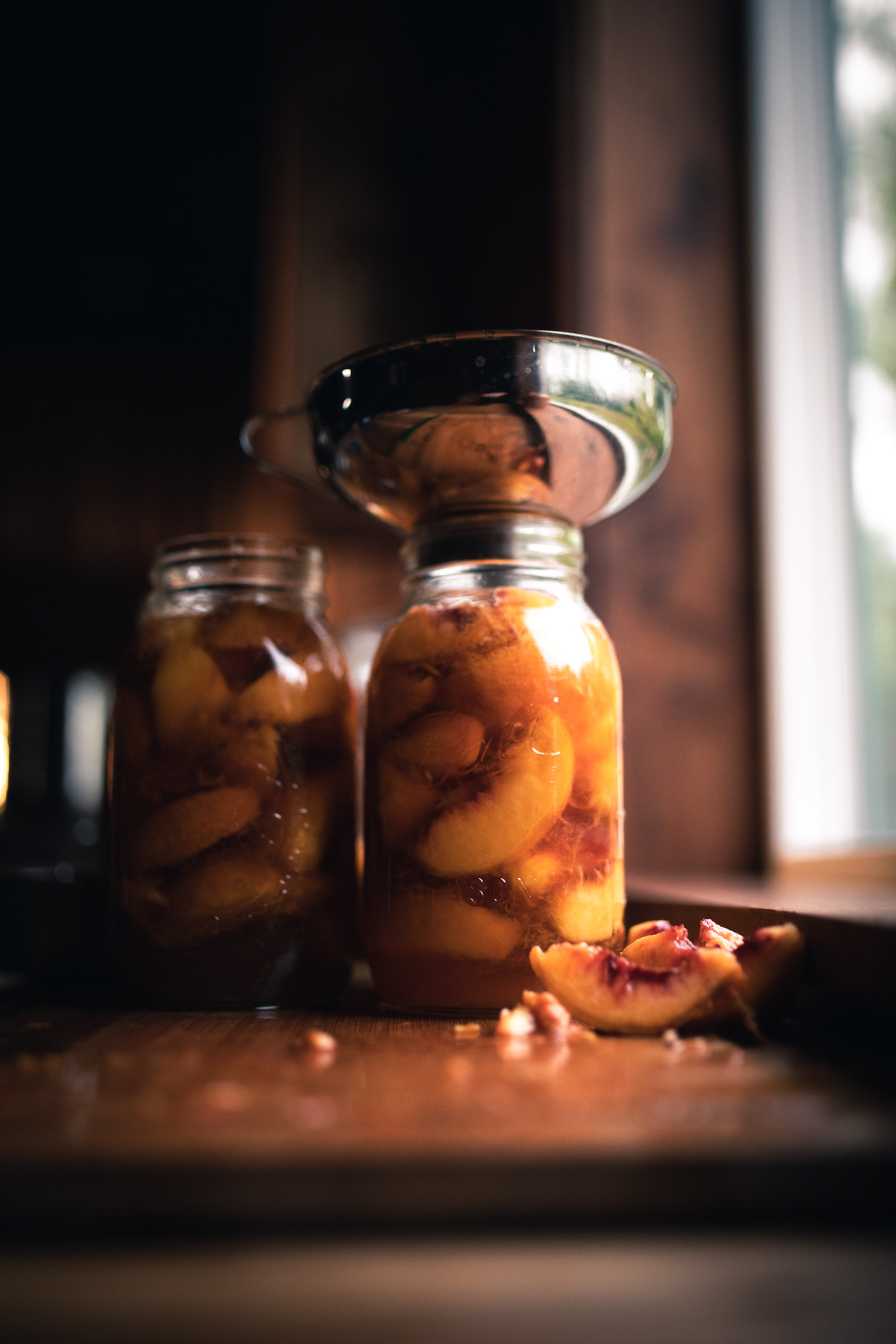
Canning Peaches Yield
Since peaches can vary significantly in size, it’s best to determine the quantity you’ll need per jar by weight. From my experience, you can stuff 1 1/4 pounds of peaches into a pint jar, while a quart jar can be filled with 2 to 3 pounds of peaches.
Of course, those weights will be slightly less if you want to can halved peaches. Because of this, I tend to cut peaches into slices for canning because they can be more densely packed into jars. The fruit will shrink during the canning process, so the more densely packed the better. Jars that have been only partially filled will end up looking like sad half-filled jars (full of very edible fruit) on your pantry shelf.
The recipe I’ve written up below will yield a 7-quart canner load (2 to 3 pounds per quart, or 17 to 18 pounds per canner load) or 9-pint canner load (1 1/4 pounds per pint, or 10 to 12 pounds per canner load).

Preparing Peaches for Canning
The prep stage of canning peaches is the most work-intensive part, but with a few tips and tricks you’ll be peeling and slicing the fruit in no time at all (and if you have help, the process will be even faster!)
Peeling Peaches
If the thought of peeling large amounts of peaches is daunting, don’t worry—I will show you a technique that will significantly reduce the time you need to spend on the task. It involves scoring the fruit, blanching them in a large pot of boiling water, and then effortlessly peeling the skins off with your fingers.
Begin by washing the peaches in cold water. I like to do this in my big farmhouse sink, which I fill up with ice and cold water after rinsing the fruit. This way, I can reuse the still-cold water for dunking the peaches in after being blanched.
Fill a large stockpot (the bigger, the better) with water and bring it to a boil over high heat. While the water is heating up, score an “x” on the bottom of each peach.

Use a spider strainer or ladle with holes to lower the peaches into the stockpot. Gives the peaches two to three minutes in the boiling water. Fruit that is slightly underripe will need more time than ripe fruit.
I like to start testing the fruit every 15 seconds or so at two minutes and go from there.
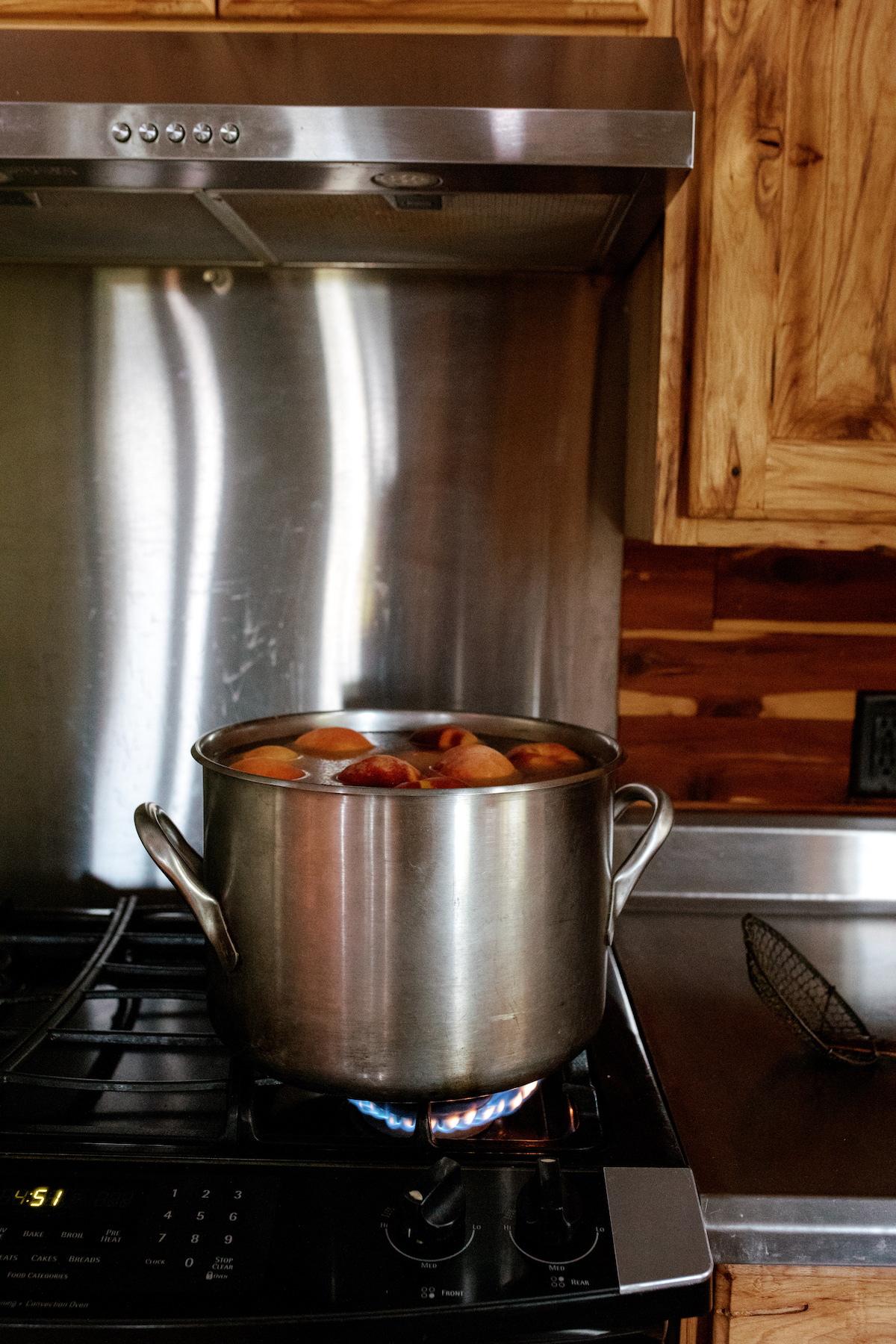
Keep testing the peaches—when the peach skins slip off easily with a clean dish towel (the peaches will be very hot, be careful not to burn your fingers), the peaches are ready for their cold water bath.

Drop the blanched peaches into the iced water. Be sure to keep extra ice on hand to ensure the temperature of the water is consistently low enough that it will cold shock the fruit.
Repeat these steps until all of the peaches are blanched and shocked in the cold water.

Peel the fruit using your fingers, the skins should just slip right off. To minimize the mess, I like to keep a bowl handy while I’m doing this for depositing the skins as I work.
Once the skin has been removed from all of the peaches, the next step is to halve or slice the fruit for canning.

Slices or Halves?
To slice the peaches, or to halve the peaches? That is the question! But I’m here to tell you that it’s entirely up to you. Think about how you’ll probably be using the peaches—will they be used to fill pies? Served for breakfast with yogurt? Eaten directly from the jar with a spoon?
If the peaches will most likely end up in baked goods, where smaller pieces make sense, then consider slicing the peaces (this also makes sense from a canning perspective, you can fit more peach slices into a jar than peach halves). Similarly, if you think the peaches will be enjoyed in larger pieces, go ahead and simply cut the peaches in half for canning.
Whether you choose slices or halves, the canning time is the same, so you can prepare a combination of both if you’d like to keep your options open.
if you want the sliced or halved peaches to maintain their original vivid color, toss them in a small amount of lemon juice or citric acid as they are being prepared. You might also want to do this if you plan on raw packing the fruit, which can lead to faster discoloration.
If using citric acid, prepare a solution with 1 teaspoon of citric acid per 1 cup of cold water.

Syrup for Canning Peaches
Because peaches are already fairly sweet without the addition of added sugar, I find that you can go pretty light on the canning syrup. In fact, you can even use water as a canning liquid if you don’t want to add any sweetness. As mentioned above, peaches are considered a high acid fruit, so they can be canned in a wide variety of liquids. In my experience, most people opt for light syrup or sometimes medium—my family likes peaches canned in extra light syrup the best.
- Water pack: The simplest option, just make sure the water is boiling hot before it’s poured into the jars. Personally, I find that water dilutes the flavor of the peaches but if you’re someone who doesn’t have any kind of sweet tooth, this might be the way to go.
- Juice pack: Apple and white grape juice can be used as a canning liquid, too. As with any kind of canning liquid for peaches, make sure the juice is boiling hot when packing the jars.
- Extra light syrup: A very light syrup will essentially match the natural sweetness of peaches. To make extra light syrup for a 9-pint canner load, use 3/4 cups sugar and 6 1/2 cups of water; for a 7-quart canner load, add 1 1/4 cups of sugar to 10 1/2 cups of water.
- Light syrup: Light syrup will add a touch of sweetness to canned peaches and this is usually the syrup I like to make. To make enough light syrup for a 9-pint canner load, use 1 1/2 cups of sugar and 5 3/4 cups of water; for a 7-quart canner load combine 2 1/4 cups sugar to 9 cups of water.
- Medium syrup: If you’re a fan of very sweet peaches, choose medium syrup (but really, these will be super sweet peaches). For a 9-pint canner load, use 2 1/4 cups of sugar and 5 1/4 cups of water; for a 7-quart canner load, use 3 3/4 cups sugar to 8 1/4 cups water.
There is also the option to make a heavy or extra heavy syrup for canned peaches. I feel confident stating that most people would find these syrups way too sweet for peaches (and as a matter of fact, if you use these syrups as a canning liquid you’re basically making candied peaches). I would definitely advise against using anything heavier than medium syrup!

Canning Peaches Recipe Variations
Want to change up the flavor of your canned peaches? Because peaches are so ideal for canning (in that they can be preserved in just about any kind of liquid), there’s more room to experiment with different sweeteners and flavors.
Honey and maple syrup make a delicious substitute for white sugar. Honey especially, as it mimics the natural sweetness of the peaches. If you want to swap sweeteners, keep in mind you’ll only need about 2/3s as much honey or maple syrup as you would sugar by volume.
For example, if you’re making a 9-pint canner batch of peaches with a very light syrup, use 1/2 cup of honey instead of 3/4 cup of sugar combined with the original 6 1/2 cups of water. Because the peaches are acidic, you can play around with the ratios until you find the perfect level of sweetness for your canned peaches.
For additional flavor, try placing a cinnamon stick or a halved vanilla bean at the bottom of each jar before adding the peaches and hot canning liquid.
Hot Pack
Hot packing peaches, which involves briefly boiling the peaches in their canning liquid before canning, might be a little bit more work (but not too much!) but this method if advantageous for a couple of reasons. When the peaches are submerged in the hot water, this drives some of the naturally-occurring air in the fruit tissue out. This not only prevents the canned peaches from browning over time, it also keeps them from floating in the jar.
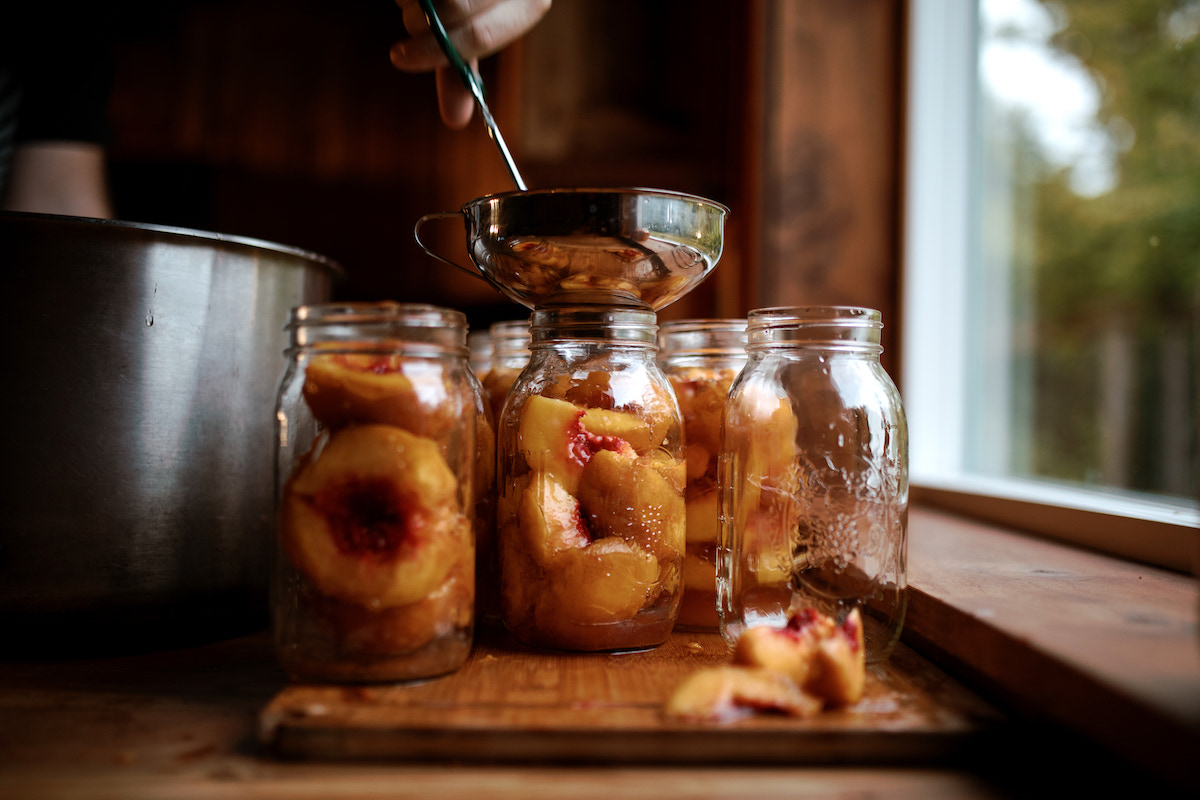
Raw Pack
Raw packing peaches for canning, on the other hand, involves packing fruit into the jars while it’s still raw. The hot canning liquid is poured over the raw fruit directly into the jar before the jars are sealed and loaded into the canner. Using the raw pack technique is definitely easier in terms of getting the fruit into the jars—you don’t have to worry about burning yourself on hot fruit. If you plan on eating the canned peaches relatively quickly, like within 2 to 3 months, then this method will work just fine. However, if the peaches are going to sit in your pantry for a longer period of time, I would use the hot pack method to prevent browning and floating fruit.
Headspace for Canning Peaches
Headspace is defined as the space between the inside of the lid and the top of the food or its liquid. Measuring headspace is important because if jars are overfilled the contents can boil out during the canning process or the lid may be prevented from sealing. The easiest way to correctly measure headspace is to use a clean ruler or even better, a canning funnel with a built-in headspace measurer.
It’s important to re-measure headspace after the syrup or other hot canning liquid is poured over the peaches and the air bubbles have been removed (I like to use a wooden chopstick for this task) and to replenish the canning liquid as needed. Ignoring headspace requirements can cause a whole host of annoying canning issues during and after processing, so it’s worth it to take a few extra minutes to make sure everything has been correctly measured.
For canned peaches, you’ll want to leave a headspace that is 1/2-inch between the canning liquid/peaches and the bottom of the lid.
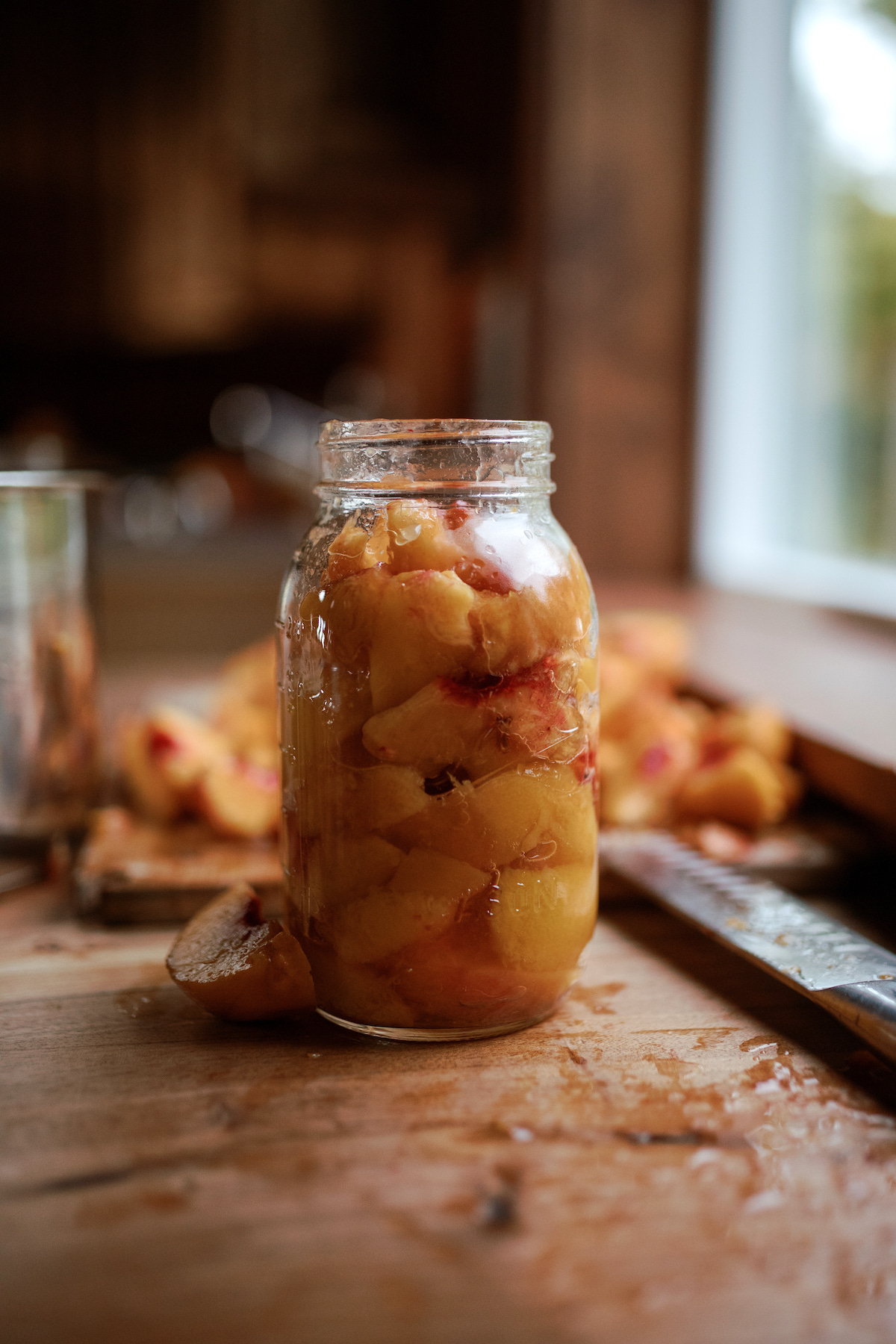
Processing Times for Canning Peaches
All canning times are from the National Center for Home Food Preservation.
If canning the peaches using a hot water bath canner, the processing times are as follows:
- For a hot pack: Pints should be processed for 20 minutes; quarts should be processed for 25 minutes.
- For a raw pack: Pints should be processed for 25 minutes; quarts should be processed for 30 minutes.
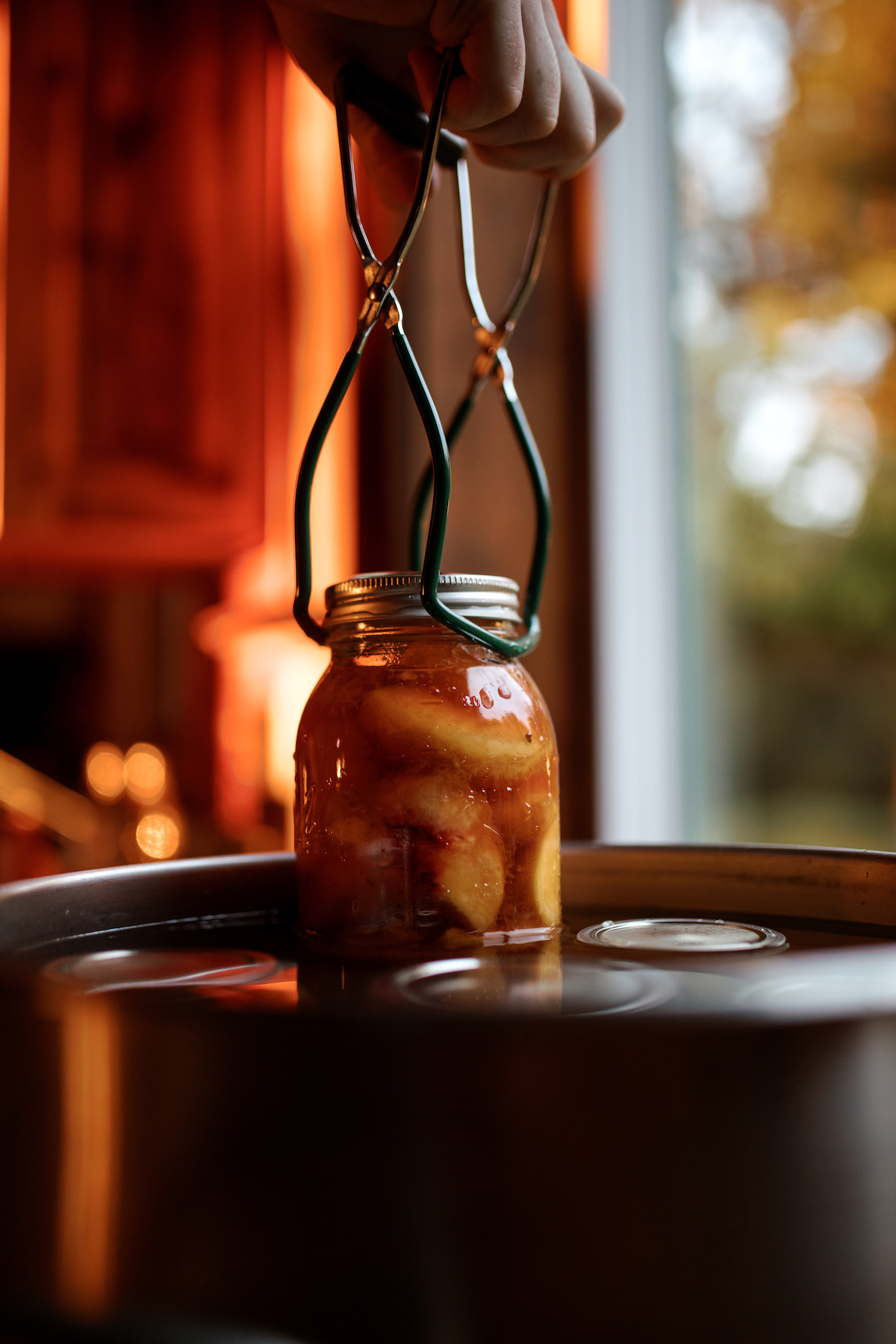
Altitude Adjustments for Canning Peaches
If you’re canning hot-packed peaches at a higher altitude, use these water bath canning times:
- If processing at an elevation greater than 1,000 feet: Pints should be processed for 25 minutes; quarts should be processed for 30 minutes.
- If processing at an elevation greater than 3,000 feet: Pints should be processed for 30 minutes; quarts should be processed for 35 minutes.
- If processing at an elevation greater than 6,000 feet: Pints should be processed for 35 minutes; quarts should be processed for 40 minutes.
If you’re canning raw packed peaches at a higher altitude, use these water bath canning times:
- If processing at an elevation greater than 1,000 feet: Pints should be processed for 30 minutes; quarts should be processed for 35 minutes.
- If processing at an elevation greater than 3,000 feet: Pints should be processed for 35 minutes; quarts should be processed for 40 minutes.
- If processing at an elevation greater than 6,000 feet: Pints should be processed for 40 minutes; quarts should be processed for 45 minutes.
Pressure Canning Peaches
Peaches are perfectly safe when processed in a hot water bath canner, but by all means use a pressure canner if you prefer.
The pressure canning guidelines below are from the National Center for Home Preservation (PSI refers to the unit of pressure, pound per square inch).
If you’re canning the peaches using a dial-gauge pressure canner, the standard guidelines are as follows:
- For a raw pack and hot pack at an elevation of 0-2,000 feet: Both pints and quarts should be processed for 10 minutes at 6 PSI
- 2,000-4,000 feet: 10 minutes at 7 PSI
- 4,001-6,000 feet: 10 minutes at 8 PSI
- 6,000-8,000 feet: 10 minutes at 9 PSI
For weighted-gauge pressure canners, follow these guidelines:
- For a raw pack and a hot pack at an elevation of 1-1,000 feet: Both pints and quarts should be processed for 10 minutes at 5 PSI
- >1,000 feet: 10 minutes at 10 PSI
Storing Home Canned Peaches
Canned peaches should be stored in a cool, dry place away from direct light. I also don’t recommend storing canned peaches in a cupboard next to an oven, as this can be major source of heat. Although canned peaches will keep on the shelf for up to 18 months, I always try to use them up within a year for best color and flavor. Plus, by getting rid of last year’s peaches, I can make room for this year’s crop of peaches.
How to Can Peaches at Home
- Weigh the peaches for canning using the guidelines above to determine how much fruit you’ll need for the canner batch size you plan on making.
- Bring a large pot of water to boil and score an “x” on the bottom of each peach. Working in batches, submerge the peaches in boiling water for 2 to 3 minutes. Remove peaches from the boiling water and shock in an iced water bath. Peel peaches with your fingers when they are cool enough to touch. Repeat until all peaches have been peeled.
- Prepare the peeled peaches for canning by halving or slicing all of the fruit.
- Bring the canning liquid of your choice to a boil. If you want to make a syrup for the peaches, refer to the tables above listed above for sugar and water proportions. I like to make an extra light syrup, which requires bringing 3/4 cup of sugar and 6 1/2 cups of water to a boil for a 9-pint canner load or 1 1/4 cups sugar and 10 1/2 cups of water for a 7-quart canner load.
- At the point, you have the option to raw pack the peaches, in which case the fruit can be added directly to the jars without being heated up, with the hot liquid simply being poured over them. That being said, I highly recommend hot packing peaches for best quality fruit. To do this, carefully add the peach halves or slices to the liquid and boil for 2 minutes before removing from the heat.
- Carefully transfer the hot peaches into prepared pint or quart jars using tongs or a large, shallow ladle. Try to pack the fruit pieces in as tightly as possible to prevent the peaches from floating.
- Secure two-piece jar lids, applying until fingertip tight. Load the jars into the canner, process according to the guidelines above.
- When the jars are ready to be taken out of the canner, carefully lift them out using a jar remover, placing them on a clean kitchen towel. Make sure to leave at least an inch of space between each jar for air circulation.
- Let the jars and their contents cool down to room temperature, a process which can take anywhere between 12 and 24 hours depending on the jar size and ambient temperature of the room.
- When the jars have cooled, inspect the lids to make sure they have been properly sealed. If you have any unsealed jars, simply store the peaches in the fridge and enjoy within 5 to 7 days.
- For sealed jars, remove the bands and save them for future home canning projects. Label and date the peaches before storing in a cool, dry place away from direct sunlight for up to 18 months.
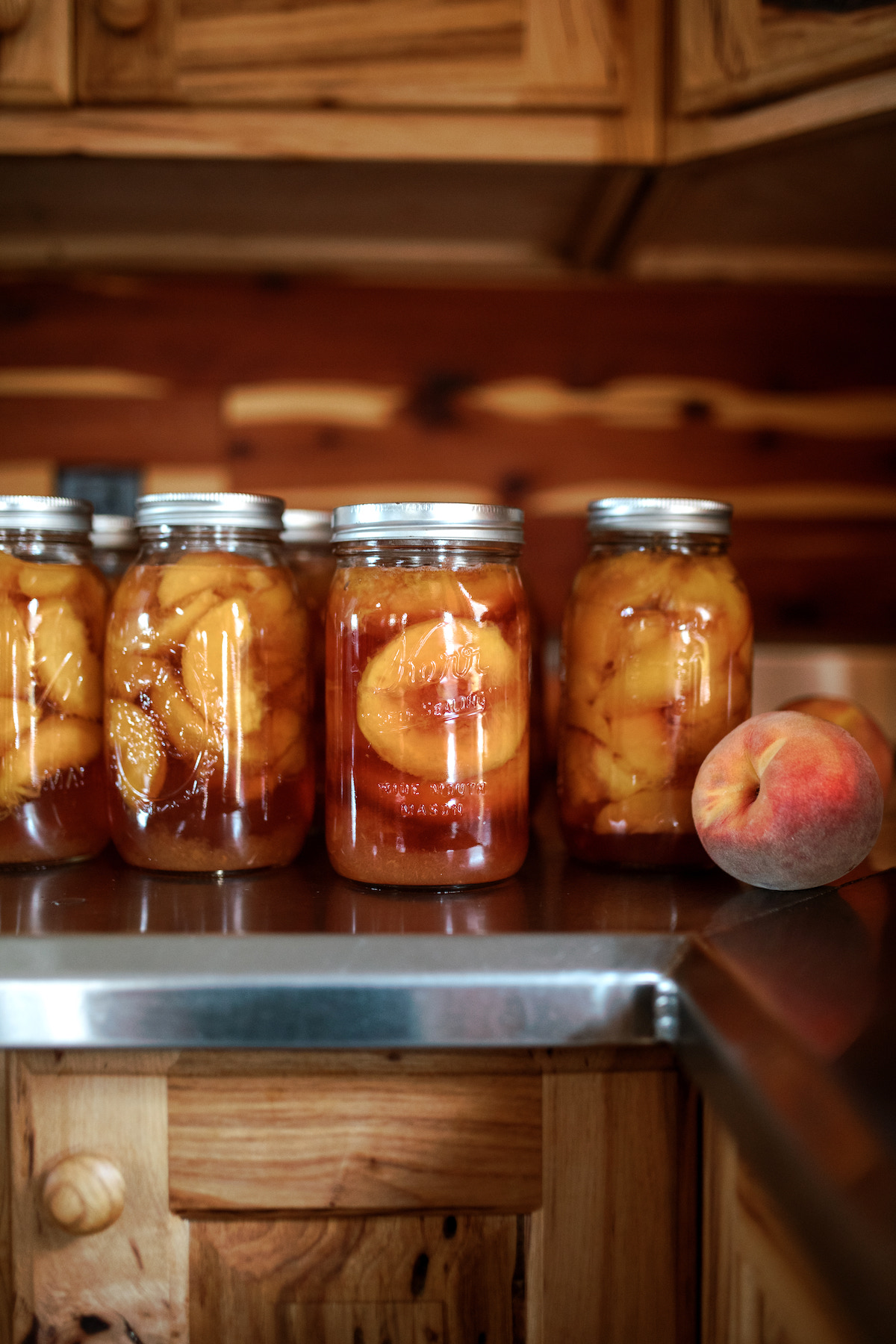
Troubleshooting Home-Canned Peaches
These are some of the most common troubleshooting issues when it comes to canning peaches. If you’re new to canning and don’t feel confident making a full batch, a great way to practice your skills is to make a smaller batch or even a single jar of canned peaches—once you get the method down, you can graduate to full canner loads using all your recently acquired skills.
The peaches fall apart during the canning process:
Always choose peaches that are semi-firm and almost ripe. To test the peaches, lightly press your finger into the peach— it should leave a slight indentation. The high heat the peaches are exposed to during the canning process (especially if a pressure canner is being used) is too much for overly soft fruit to withstand, so it tends to fall apart.
The peaches are floating to the top of the canning liquid:
If you notice the peaches floating in the canning liquid, there are a few factors that could be at play. Raw packed peaches contain a lot of air which can cause the fruit to float, this can easily be prevented by hot packing the peaches instead. Another common culprit is fruit that has been packed into the jar loosely—make sure the peaches are tightly packed when you make your next batch. When fruit is processed for too long some of the fruit’s natural pectin can be destroyed, which can also lead to floating fruit.
There was liquid loss during the processing stage:
Liquid loss is often the result of incorrect headspace (usually when jars are overfilled), but there are several other reasons this common issue could be occurring. One reason is if the jars are removed from the boiling water too quickly; always turn off the heat and let the jars sit in the hot water for 5 minutes before carefully removing. Liquid loss can also occur when the jars aren’t covered by at least 1 inch of water in the canner.
The peaches discolor and turn brown:
When it comes to discolored peaches, there are a couple of possible causes. Browning is more likely to occur if the temperature of the water is too low or if the jars are not covered by at least 1 inch of water. If the water temperature is too low (ie: drops below boiling during processing), this could also lead to discoloration. Finally, if the jars experience liquid loss while in the canner the peaches could potentially darken.
Remember, however, that while discolored peaches might not be as pretty, they’ll still taste just as delicious as the colored version.
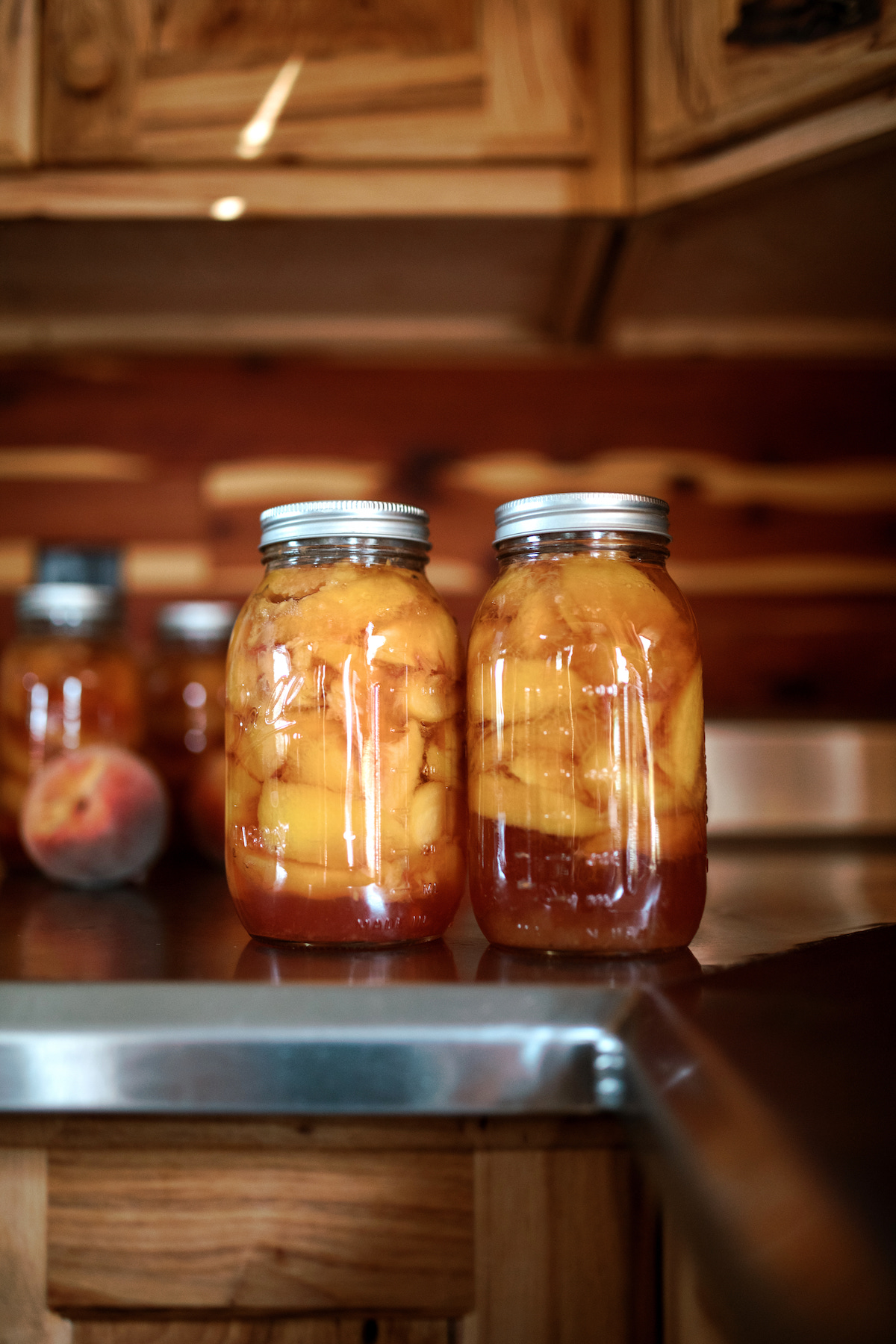
Ways to Use Home-Canned Peaches
Having actual summer peaches at your disposal opens up an entire world of possible uses. Some of my favorite ways to incorporate canned peaches into meals and recipes include:
- Using the peaches as a topping for ice cream, yogurt, or cottage cheese
- Spooning sliced peaches onto oatmeal or rice pudding
- Replacing maple syrup with peaches and their syrup for pancakes, French toast, and waffles
- Adding canned peaches to smoothies and milkshakes
- Using the peaches in savory recipes for chutneys and salsas
- Serving the canned peaches with roasted pork, boar, or venison (or any other meat or game that pairs well with sweet flavors)
- Incorporating the peaches and their syrup into a peachy cocktail, spritzer, lemonade, or fruit-infused seltzer water
- Adding sliced peaches to bakes goods and pastries (freshly baked peach pie on a cold winter day is the equivalent of sunshine when daylight hours are scarce)

Canning Peaches FAQ
At this point, I’ve covered just about everything you need to know when canning peaches at home. Here’s the quick frequently asked questions guide to making sure no stone is left unturned!
How Long Does Canning Peaches Take?
The time it takes to process peaches depends on the size of the jar (pints or quarts), whether a raw pack or a hot pack has been used, and the type of canner being used (water bath canner or pressure canner). Refer to the information above if you’re canning at a higher altitudes as processing times will need to be increased.
The peeling and slicing stage is what takes the longest when making canned peaches, but if you have a helper (or two!) you can easily cut the prep time in half.
Using a water bath canner, a pint-size hot pack will take 20 minutes and a quart-size hot pack will take 25 minutes to process.
Using a water bath canner, a pint-size raw pack will take 25 minutes and a quart-size raw pack will take 30 minutes.
The processing time for pressure canners is considerably shorter.
Using a dial-gauge pressure canner, both hot and raw packed pints and quarts will need 10 minutes at 6 PSI.
Using a weighted-gauge pressure canner, both hot and raw packed pints and quarts will need 10 minutes at 5 PSI.
How Many Peaches Do You Need for Canning?
For recipe accuracy, I always weigh my peaches. I find that 1 1/4 pounds of peaches will fit in a pint jar and I’ll need 10 to 12 pounds of peaches for a 9-pint canner load. For quarts, you’ll need 2 to 3 pounds per jar of 17 to 18 pounds of peaches per 7-quart canner load.

How Much Sugar Do You Add When Canning Peaches?
This amount of sugar will vary depending on your sweetness preferences. For guidance and measurements, please refer to the syrup for canning peaches section above.
Which is Better, Canning or Freezing Peaches?
Again, I think this is very much a preference thing and each method has its pros and cons. In terms of nutrition, frozen peaches don’t contain added sugar and canned peaches are more likely to be preserved in syrup (although you can always use water in place of syrup or juice, my only recommendation would be to hot pack the fruit). On the other hand, canned peaches have a longer shelf life and are ready to go, take up less space, and are ready to go, straight from the jar—no defrosting required. Choose whichever method works for you and your space, or opt for a mixture of both (especially if you’ve been gifted with a bumper crop of peaches).
Do You Have to Use Citric Acid (or lemon juice) for Canning Peaches?
Because peaches are a high-acid fruit, there is no need to add citric acid or lemon juice to a recipe for canned peaches for the sake of food safety. When acid is added to canned peaches, it’s typically done to discourage discoloration.

Canning Peaches
Ingredients
- Whole peaches*
- Granulated sugar**
- Water**
Instructions
- Peel peaches by scoring an "x" in the bottom of each fruit, submerging in boiling water, and shocking in water with ice cubes.
- Slice or halve peeled peaches.
- In a large stockpot, combine water and granulated sugar. Bring to a boil.
- Add peaches to boiling syrup and simmer for 2 minutes. Remove from heat.
- Carefully pack prepared jars with hot fruit. Cover with hot syrup, leaving 1/2-inch headspace. Remove air bubbles with a chopstick and adjust canning liquid if needed to fulfil headspace requirements.
- Load jars into water bath canner and process for 20 minutes (pints) or 25 minutes (quarts). See notes for altitude adjustments and guidelines for pressure canning.
- Remove jars from canner after processing and use a canning jar lifter to transfer hot jars to a clean surface lined with a kitchen towel—leave at least 1 inch of space between each jar.
- Allow the jars and their contents to come to room temperature (this will take between 12 and 24 hours).
- Check seals on each jar, storing any unsealed jars in the refrigerator; use within 5 to 7 days,
- Remove bands from sealed jars. Label, date and store canned peaches in a cool, dry location away from direct sunlight for up to 18 months.
Notes
- If processing at an elevation greater than 1,000 feet: Pints should be processed for 25 minutes; quarts should be processed for 30 minutes.
- If processing at an elevation greater than 3,000 feet: Pints should be processed for 30 minutes; quarts should be processed for 35 minutes.
- If processing at an elevation greater than 6,000 feet: Pints should be processed for 35 minutes; quarts should be processed for 40 minutes.
- For a hot pack at an elevation of 0-2,000 feet: Both pints and quarts should be processed for 10 minutes at 6 PSI
- 2,000-4,000 feet: 10 minutes at 7 PSI
- 4,001-6,000 feet: 10 minutes at 8 PSI
- 6,000-8,000 feet: 10 minutes at 9 PSI
- For a hot pack at an elevation of 1-1,000 feet: Both pints and quarts should be processed for 10 minutes at 5 PSI
- >1,000 feet: 10 minutes at 10 PSI
Peach Canning Recipes
While canning peaches as halves or slices is one of the simplest ways to preserve them, there are plenty more peach canning recipes you can try!
Fruit Canning Recipes
Looking for more ways to preserve fruit in a jar?





I’ve been canning peaches for over 40 years and this was the very best instructions and process ever!So glad I checked it out! I will use this forever! Easiest and most efficient method I have ever used. Thank you!
Wonderful, so glad it’s helpful to you Karen!
First time canning peaches by themselves, and I need to remember to trust the alchemy – the peaches are beautiful in their jars. I am looking forward to opening them this winter! I have a lot of peach-infused syrup left. Is there a use for this? I’m going to can it (almost three pints!) and see what turns up. Thank you for the recipe!